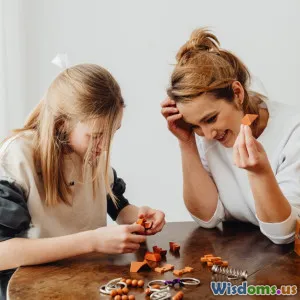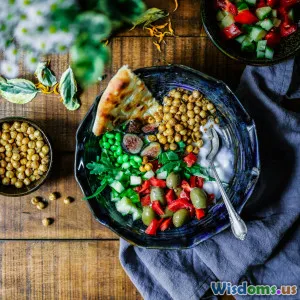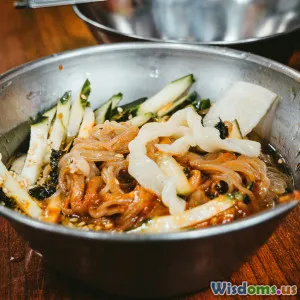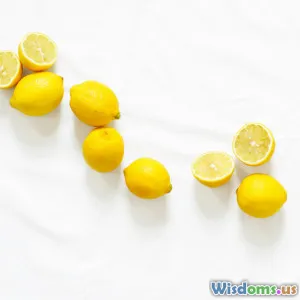
Why Do Professional Chefs Use Odd Numbers in Garnishing
9 min read Explore why professional chefs prefer odd numbers in garnishing for aesthetic appeal, psychological impact, and enhanced dining experience. (0 Reviews)
Why Do Professional Chefs Use Odd Numbers in Garnishing?
If you’ve ever admired a beautifully plated dish at a fine dining restaurant, chances are there was a careful selection of garnish arranged in odd numbers—three leaves of basil, five slices of radish, or seven dots of sauce. This subtle yet deliberate choice is no accident. Professional chefs understand the powerful psychology and aesthetics behind odd-numbered garnishing. But why exactly do odd numbers dominate in the world of plating? This article will unpack the science and art behind it and show how incorporating odd numbers can elevate not only the look of your dish but also the entire dining experience.
The Fundamentals of Visual Appeal in Food Presentation
Before diving into the specifics of odd vs. even, it’s important to recognize that the core goal of garnishing is to enhance the food visually—and sometimes even texturally or aromatically—without overpowering the main components.
Visual harmony attracts human attention and can stimulate appetite. Food presentation techniques are designed to invoke a sense of curiosity, pleasure, and balance.
Pattern Recognition and the Brain
Humans are pattern-seeking beings. The brain tends to favor certain arrangements based on historical, evolutionary, and cultural conditioning.
- Symmetry and patterns often convey order and aesthetic satisfaction.
- However, absolute symmetry might be perceived as unnatural or uninviting in culinary settings.
Odd numbers strike a unique balance—they offer a pattern but also subtle asymmetry that triggers more visual interest and engagement.
Why Odd Numbers? Psychological and Artistic Insights
1. Odd Numbers Create a Natural, Dynamic Look
Odd-numbered groupings feel less artificial or staged. When you spot three strawberries on a plate compared to two or four, the trio appears more spontaneous and organic.
Professional chef and food stylist Karen Page notes, “Odd numbers attract our eyes and hold our attention longer. They seem more natural and less mechanical.”
2. Odd Numbers Encourage Visual Movement
Odd number arrangements, such as three portions or five dots of sauce spaced irregularly, create an optical rhythm. This encourages the eyes to move around the plate exploring details rather than focusing on a single symmetrical point.
This can be explained by the "golden ratio" and principles of design:
- Even groupings can create a sense of stasis.
- Odd groupings build movement and flow.
3. Odd Numbers Are Perceived as Balanced Yet Inviting
Inartistic terms, odd numbers prevent static rigidity but maintain enough organization to be aesthetically satisfying. For example, three herbs placed thoughtfully across a dish create balance without making the plate look too uniform.
4. Odd Numbers Align with the Rule of Odds in Design
The "rule of odds" is a principle found in various artistic disciplines—from painting and photography to interior design—and states that an odd number of elements is more appealing visually than an even number.
Similarly, Michelangelo’s sculptures often present face or figure groupings in odd numbers for dynamic realism.
5. The Psychological Impact on Eating Experience
Studies in consumer psychology suggest that plating appealing compositions with odd-numbered elements can:
- Enhance perceived taste quality
- Increase the emotional satisfaction of the meal
- Influence diners to appreciate the chef’s craftsmanship more deeply
Real-World Examples of Odd Number Garnishing
Fine Dining Masters
-
Thomas Keller, renowned for The French Laundry, often plates in odd groups — three sprigs of microgreens or five drops of flavored oil to create dynamic visual cues.
-
Heston Blumenthal incorporates three-point garnishes or artistic odd splashes of foam to engage the viewer's senses more fully.
Home Cooking and Plating Tips
Try placing:
- Three lemon wedges arranged in a triangular shape
- Five cherry tomato halves scattered attractively
- Seven tiny basil leaves artistically placed around the main entree
This will immediately elevate the presentation compared to even-number arrangements.
Pastry and Cocktail Garnishes
-
Odd numbers are also common in dessert plating: three raspberries or five chocolate shavings provide visual interest.
-
Top mixologists garnish cocktails with odd-numbered citrus slices or herbs to create visually complex yet balanced drinks.
Science Behind Odd Numbers in Visual Perception
Cognitive and Neurological Aspects
Psychology and neuroscience reveal that odd numbers stimulate the brain differently:
-
Odd groupings require more cognitive effort to process, increasing viewer engagement.
-
Odd numbers offer asymmetry, which tends to retain attention longer than perfect symmetry.
Evolutionary Perspectives
Historically, humans may have interpreted odd patterns as signals of environment complexity or ripe bounty—an evolutionary advantage for foraging and survival.
While not definitive, it’s a compelling argument for ingrained preferences toward odd groupings in nature and art.
Practical Application for Home Cooks and Aspiring Chefs
How to Harness Odd Numbers in Your Garnishing
- Always consider odd counts (3, 5, 7) when sprinkling herbs, placing slices, or dotting sauces.
- Use an uneven grouping to lead the diner’s eye along a path.
- Avoid overcrowding; less is often more, and odd placements keep the plate uncluttered.
Experiment and Observe
Take a photograph of your plate with odd and even numbers of garnishes. Notice which composition feels more attractive or compelling to you.
Over time, you’ll develop an intuitive instinct for how odd numbers can elevate not just garnish placement but the entire dining experience.
Conclusion: The Art and Science of Odd Numbers in Garnishing
The use of odd numbers in garnishing transcends mere superstition or tradition; it is a thoughtful blend of psychology, art, and culinary science. Through creating natural, dynamic, and visually pleasing compositions, odd numbers captivate diners and stimulate the senses beyond taste alone. Professional chefs leverage this simple yet powerful rule of odds to craft memorable meals that engage the mind and appetite alike.
By adopting odd-number garnishing strategies in your kitchen, whether as a professional or a home cook, you invite a deeper appreciation of food’s visual language and enhance every dining experience.
Next time you plate a meal, remember: sometimes, less (and oddly numbered) truly is more.
References and Further Reading:
- Page, Karen. "Plate it Perfect: Using the Rule of Odds". Journal of Culinary Science & Technology, 2019.
- Brown, Alton. Good Eats: Feast of Visual Perception. Public Broadcasting, 2017.
- Watson, Helen. "Cognitive Responses to Food Presentation". Psychology Today, 2021.
Rate the Post
User Reviews
Other posts in Meal Plating & Presentation
Popular Posts
















